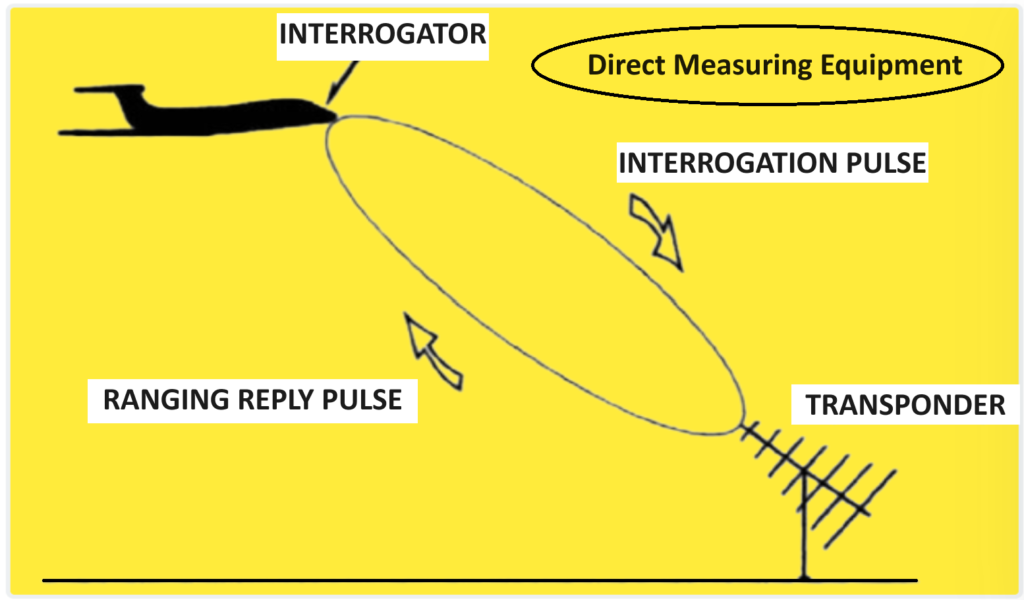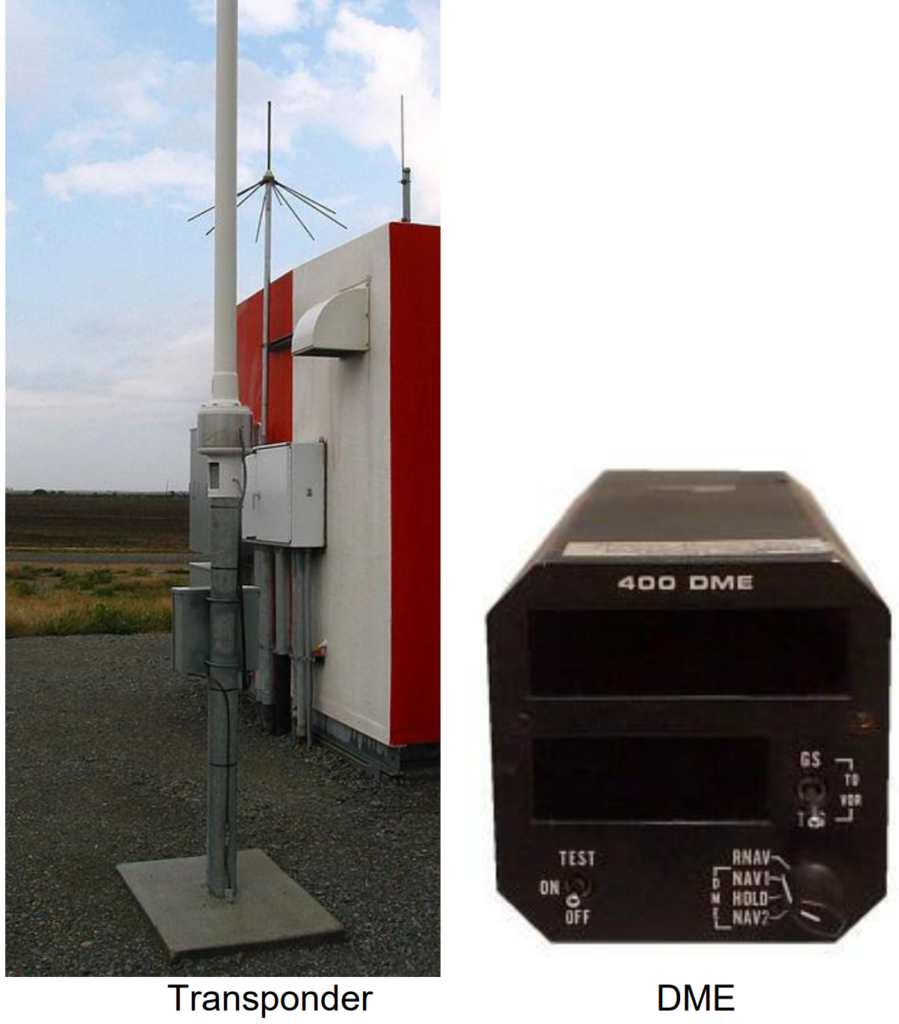Distance Measuring Equipment (DME) is a radio navigation technology that calculates distance by measuring the time it takes for radio signals to travel between an aircraft and a ground station. Here are some key points about distance measuring equipment:
- Invention and Development: DME was developed in Australia in the early 1950s by James Gerry Gerrand and Edward George “Taffy” Bowen. It was initially used domestically in Australia by Amalgamated Wireless Australasia Limited before being adopted internationally.
- Operation: DME operates by sending and receiving VHF or UHF radio signals between the aircraft and ground stations known as transponders. The system measures the time it takes for the signals to travel between the aircraft and the ground station to calculate the distance.
- Similarity to Secondary Radar: DME functions similarly to secondary radar systems used for aircraft identification. However, in DME, the aircraft sends signals to ground stations, whereas in secondary radar, ground stations send signals to aircraft.
- Compatibility with TACAN: DME is functionally identical to the distance measuring component of TACAN (Tactical Air Navigation). TACAN combines DME distance measuring capabilities with azimuth information to provide both distance and direction to aircraft.
- International Adoption: DME technology was adopted internationally by the International Civil Aviation Organization (ICAO), becoming a standard component of air navigation systems around the world.
Overall, distance measuring equipment plays an important role in aviation navigation by providing accurate distance measurements to aircraft, helping pilots navigate safely and efficiently, especially during instrument approaches and en-route navigation.

DME Operation & How it Works?
Distance Measuring Equipment (DME) is a radio navigation technology used by aircraft to determine their distance from ground-based transponders. Developed in Australia, it operates by measuring the propagation delay of VHF or UHF radio signals. The system consists of ground-based transponders, typically collocated with VORs (VHF Omnidirectional Range), and onboard equipment installed in aircraft. DME transponders emit pairs of pulses towards aircraft, which then transmit response pulses back to the ground station. By timing the round-trip interval of these pulses, the system calculates the distance between the aircraft and the ground station.
Ground-based distance measuring equipment transponders are equipped with a 1 kW peak pulse output on assigned UHF channels, ensuring reliable communication with aircraft over considerable distances. These transponders can be installed for both en-route and terminal navigation, providing crucial distance information to pilots during various phases of flight. Additionally, in some installations, low-power DME units are colocated with ILS (Instrument Landing System) glide slope antennas, offering precise distance measurements for aircraft approaching a runway.
The operation of distance measuring equipment is straightforward yet effective. Aircraft continuously transmit pulse pairs towards ground transponders, while simultaneously receiving response pulses. By measuring the time it takes for these pulses to travel to and from the ground station, DME calculates the slant range distance between the aircraft and the transponder. This distance information aids pilots in accurately determining their position during flight, especially when navigating through complex airspace or executing instrument approaches in adverse weather conditions.
Distance Measuring Equipment Components.
The hardware components of the distance measuring equipment system consist of an interrogator installed in the aircraft and a transponder located on the ground. The interrogator serves as the onboard transmitter/receiver, while the transponder functions as the ground-based receiver/transmitter. These components are designed to facilitate communication between aircraft and ground stations, enabling the exchange of pulse signals that determine distance measurements.
In the aircraft, the interrogator is responsible for transmitting pulse pairs towards the ground transponder and receiving response pulses. This device is typically installed as part of the aircraft’s avionics system and is integrated with other navigation equipment to provide pilots with accurate distance information during flight. The interrogator operates on the UHF frequency band, ensuring compatibility with ground-based transponders.

On the ground, the transponder serves as the counterpart to the interrogator in the aircraft. It receives pulse signals from aircraft interrogators and transmits response pulses back to the aircraft. These ground-based transponders are strategically located at fixed positions, often collocated with VORs or ILS installations, to provide comprehensive coverage across airspaces and flight paths.
DME Timing
In the SEARCH mode of the DME system, the aircraft initiates communication by transmitting a series of 150 interrogation pulse-pairs per second towards the ground transponder. After a precise time delay of typically 50 microseconds, the ground station responds with an identical sequence of pulse-pairs. The distance measuring equipment receiver onboard the aircraft then scans for reply pulse-pairs with the correct interval and pattern matching its original interrogation. Any pulse-pairs that do not synchronize with the aircraft’s interrogation pattern are categorized as filler pulse-pairs, also known as Squitter. Additionally, replies intended for other aircraft, which are therefore non-synchronous, also appear as squitter.
In the TRACK mode, the number of interrogation pulse-pairs per second is reduced to less than 30, ensuring that the average amount of pulses in both SEARCH and TRACK modes does not exceed 30 pulse-pairs per second. Once the aircraft interrogator identifies a reply pulse sequence with the same spacing as the original interrogation sequence, it locks onto the distance measuring equipment ground station. Once locked on, the receiver has a narrower window to search for echoes and can maintain lock on the ground station more effectively. This locking mechanism enhances the stability and accuracy of distance measurements provided by the DME system, improving navigation reliability for pilots during flight.
DME Distance calculation
The DME system calculates distance by measuring the time it takes for a radio signal to travel from the aircraft to the ground transponder and back, a distance known as a radar-mile. This travel time is approximately 12.36 microseconds for every nautical mile (1,852 meters). After accounting for the 50-microsecond delay introduced by the ground transponder, the DME receiver’s timing circuitry calculates the time difference between the interrogation and reply signals.
Using the formula distance = rate * time, where the rate is the velocity of the radio pulse (the speed of light, roughly 300,000,000 meters per second or 186,000 miles per second), and the time is the adjusted time difference (total time minus 50 microseconds, divided by 2), the distance measuring equipment receiver determines its distance from the ground station. This distance measurement, known as slant range, is then displayed on the cockpit DME display, providing pilots with real-time information about their aircraft’s distance from the navigation aid.
DME Accuracy
The accuracy of DME ground stations is typically within 185 meters (or approximately 0.1 nautical miles), as per international standards set by organizations such as the FAA, EASA, and ICAO. It’s essential to note that DME provides the physical distance from the aircraft to the DME transponder, commonly referred to as “slant range.” This measurement depends on both the altitude above the transponder and the ground distance from it, calculated trigonometrically.
To ensure the required level of accuracy, flight inspection organizations conduct periodic checks of critical parameters using properly equipped aircraft to calibrate and certify distance measuring equipment precision. These inspections help maintain compliance with international standards and ensure the reliability of DME navigation for pilots and air traffic controllers.
ICAO recommends an accuracy standard of less than the sum of 0.25 nautical miles plus 1.25% of the distance measured. This standard helps maintain consistency and reliability across DME installations worldwide, enhancing the safety and efficiency of air navigation.
DME Specification
A typical DME transponder is designed to provide distance information to a considerable number of aircraft simultaneously, ranging from 100 to 200 aircraft at a time. However, to prevent overload, the transponder has built-in mechanisms to manage high traffic situations. When the number of aircraft exceeds this limit, the transponder automatically adjusts its sensitivity to limit the reception of interrogation signals. As a result, it may ignore replies to weaker, more distant interrogations, reducing the overall load on the transponder. This adaptive mechanism helps ensure efficient operation and accurate distance measurements for all aircraft within the system’s capacity.
Radio Frequency and Modulation Data
DME (Distance Measuring Equipment) frequencies are paired with VOR (VHF Omnidirectional Range) frequencies, ensuring compatibility and seamless integration. When a pilot selects a VOR frequency, the aircraft’s DME interrogator automatically tunes to the corresponding DME frequency. The DME system operates within the frequency range of 1025 to 1150 MHz.
For transmission, DME transponders use channels in the range of 962 to 1213 MHz, while receiving signals on corresponding channels between 1025 to 1150 MHz. Within this frequency band, there are 126 channels designated for interrogation and 126 channels for reply. The frequencies for interrogation and reply always differ by 63 MHz. Each channel has a spacing of 1 MHz, and the signal spectrum width is 100 kHz.
Technical specifications include X and Y channels, which refer to the spacing of individual pulses in the DME pulse pair. X channels have a spacing of 12 microseconds, while Y channels have a spacing of 30 microseconds.
Distance measuring equipment facilities are identified by a Morse code three-letter identity transmitted at a frequency of 1,350 Hz. If a DME facility is co-located with a VOR or ILS (Instrument Landing System), it shares the same identity code as the parent facility. Additionally, the distance measuring equipment facility identifies itself between transmissions from the parent facility. This distinctive identity frequency of 1,350 Hz helps differentiate DME signals from those of VOR or ILS systems, which use different frequency tones.
Terminal DME
A terminal distance measuring equipment, often labeled as TDME on navigational charts, is a specialized type of DME designed to indicate a distance of zero when an aircraft is at the threshold point of a runway, regardless of the actual physical location of the distance measuring equipment.
These TDME units are commonly associated with Instrument Landing Systems (ILS) or other precision instrument approaches. By providing a distance reading of zero at the runway threshold, they assist pilots in determining their position relative to the runway during the final stages of approach and landing. This feature enhances situational awareness and aids in making precise landings, especially during low-visibility conditions or when conducting instrument approaches.